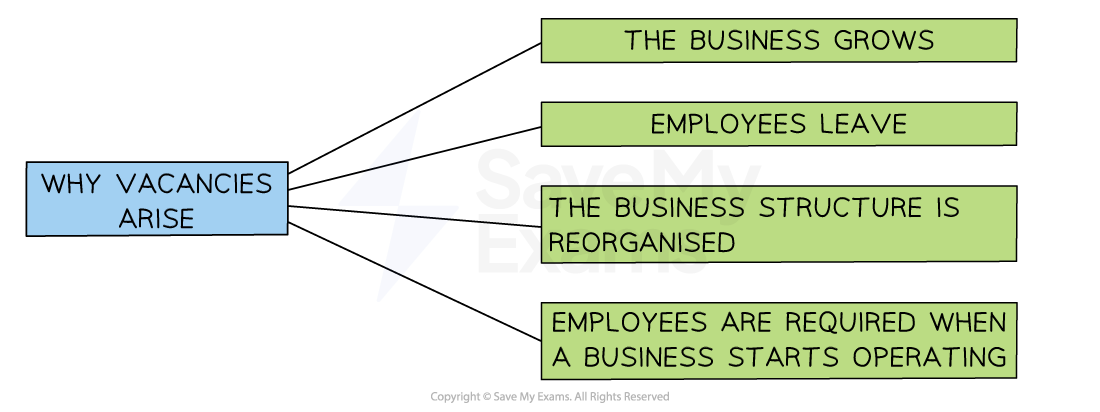Syllabus Edition
First teaching 2025
First exams 2027
Recruiting & Selecting Employees (Cambridge (CIE) IGCSE Business): Revision Note
Exam code: 0450, 0986 & 0264, 0774
The recruitment process
Recruitment is the process of attracting and identifying potential job candidates who are suitable for a vacant role
Recruitment activities include job advertising, job fairs, social media outreach and referrals from current employees
Reasons why vacancies arise

During periods of business growth, more employees are needed as the business expands its operations
When an employee leaves their job and needs replacing
Businesses often reorganise their organisational structure, which may result in the need for additional staff
A new business start-up needs to recruit workers for the first time
Businesses can choose to use a recruitment agency to carry out the recruitment and selection process on their behalf
New employees may be found quickly from its pool of available talent
Management time can be saved
Recruitment agencies usually charge a finding fee for their specialist services
Online recruitment has become increasingly popular, with sites such as LinkedIn and Indeed helping businesses to share vacancy details and compare applicants
Stages in the recruitment process

Step 1: Define the role
Businesses should determine exactly what is required and part of that is developing a job description and a person/job specification
A job specification (sometimes known as a person specification) outlines the qualifications, skills, experience, and personal qualities required from a candidate for a specific job e.g. problem solver, good communicator, able to code in Java etc.
A job description outlines the duties, responsibilities, and requirements of a particular job
Comparing a person specification with a job description
Job specification | Job description |
|---|---|
|
|
Step 2: Determine the source of employees
Internal recruitment involves a business promoting or redeploying workers that already work for them
Advantages and disadvantages of internal recruitment
Advantages | Disadvantages |
|---|---|
|
|
|
|
|
|
External recruitment involves bringing in new workers from outside of the business
External recruitment can bring fresh ideas, experiences and perspectives to the organisation
Advantages and disadvantages of external recruitment
Advantages | Disadvantages |
|---|---|
|
|
|
|
|
|
Step 3: Advertise the role
Roles may be advertised internally or externally
If the business is seeking an internal candidate, business newsletters, staff noticeboards or internal email can be used to display job advertisements
Line managers may be asked to recommend suitable candidates following appraisals
External candidates can be targeted with advertisements in newspapers, industry magazines, specialist recruitment websites, agencies and government-run agencies such as Job Centres
Existing employees may be asked to nominate people they know for roles , sometimes receiving a reward if their nominee is successfully recruited
Headhunting can be used to fill high-level roles
Businesses with a strong social media presence can use these platforms to advertise cost effectively e.g. Facebook, LinkedIn, TikTok
Specialist recruitment portals may be used to advertise, such as The Times Educational Supplement, one of the main publications and websites in the UK used to recruit teaching staff
Examiner Tips and Tricks
Avoid mixing up a job description and a person specification – one explains the role, the other describes the qualities and skills of the applicant
Selection methods
The selection process involves receiving applications, shortlisting candidates and choosing the most appropriate person(s) for the role
Receiving applications
The business may accept applications from candidates via Curriculum Vitae (CV) and covering letter or application form
Once applications have been received, the business shortlists suitable candidates
Candidates who best meet the essential and desirable criteria for the job opening in question are invited to the next stage of the recruitment process
Comparing application methods
Application form | Curriculum vitae (CV) | Covering letter |
|---|---|---|
|
|
|
Selection methods
A variety of methods can be used to select the right worker for the role
Interviews
Interviews are commonly used to meet with candidates

They usually include a face to face, telephone or online discussion between a manager and the candidate about their suitability for the role
It is important to prepare a set of relevant questions to ask all candidates and to ensure that the interview is conducted in a fair and consistent manner
Interview questions may focus on
Skills and experiences that are relevant to the job
Successes and failures - and how these were overcome
Personal interests and experiences
Selection tests
Candidates may be asked to undergo a test to demonstrate their skills and suitability for the job
Candidates may be asked to complete tests individually or within groups to assess how they may work as part of a team
The different types of tests may include:
Skills tests (e.g. numeracy) show the ability of candidates to carry out certain tasks
Aptitude tests show the candidate’s potential to improve or increase their skills
Intelligence tests are used to assess the candidate’s ability to work at a desired level
Personality tests are used to identify desired characteristics or traits such as the ability to work effectively in a team
Assessment centres
Assessment centres bring together a group of candidates to take part in a range of activities over a day or more
Candidates may be observed completing tasks such as
Group discussions
Problem-solving exercises
Presentations
Role-plays
This method allows employers to assess a range of skills like communication, teamwork, leadership and decision-making
Assessment centres are especially useful when selecting for senior or important roles
References
This involve contacting people who have worked with the candidate before, such as previous employers or teachers
References provide information about the candidate’s past performance, attitude, reliability and behaviour
They help to check that the candidate is honest about their experience and suitable for the role
They are usually collected after interviews but before making a final job offer
Choosing who to employ
The final decision of which applicant to employ depends on several factors
Even when a suitable candidate is identified, the business will need to think about whether it can finalise their appointment
Can the business fulfil the applicant's pay and conditions demands?
Can appropriate fringe benefits be offered?
Are attractive development opportunities available to the applicant?
Factors used to select the best applicant
Factor | Explanation |
|---|---|
Experience |
|
Qualifications |
|
Internal or external candidate |
|
Gut feeling |
|
Case Study
Recruiting For A Children's Bookshop
A small children's bookshop business has received two applications for its advertised sales assistant role
The shop owner is keen to select a knowledgeable candidate who is capable of delivering good customer service, communicating effectively with its (often young) customers and being willing to support administrative tasks such as banking cash
Which of these two applicants would likely be appointed?

Applicant analysis
Amira scored better in the assessment tests. She was nearly 20% better in communication
Amira has had two weeks experience of working with kids, which will suit this role nicely
Amira also has a first aid qualification, which is a useful skill when working with kids
Overall, Amira is a better fit for the role advertised

Unlock more, it's free!
Did this page help you?